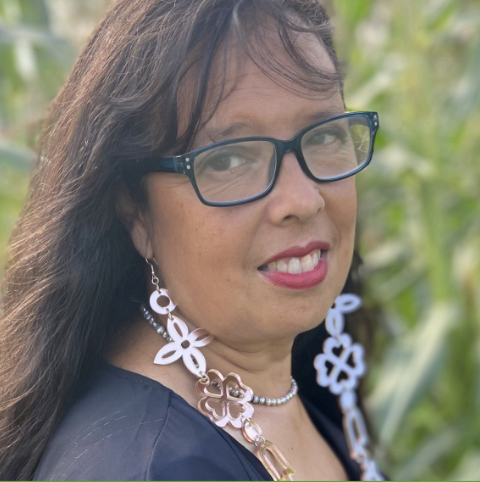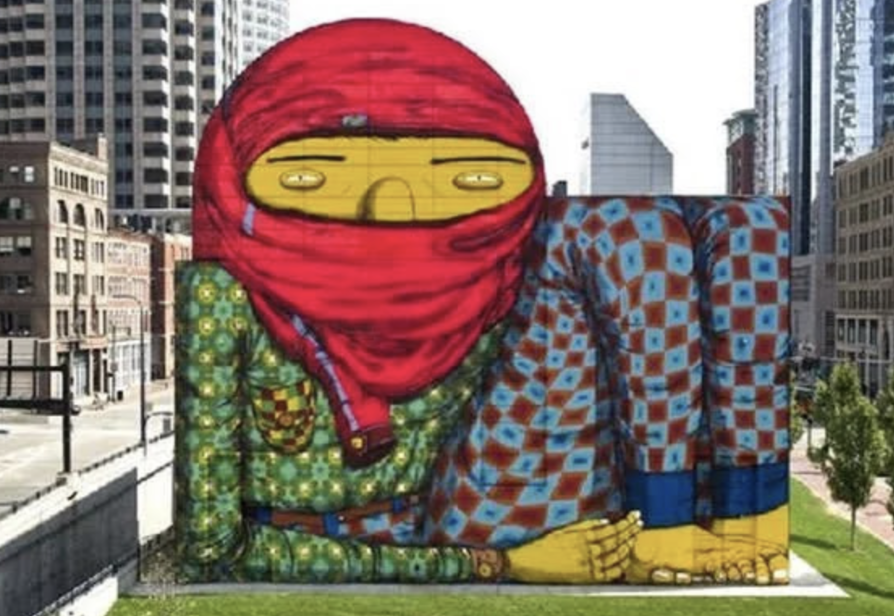PUBLIC ART on the COMMON
Our three parks parks are home to 42 pieces of public art – the largest collection in Boston. Temporary public art gives us all the opportunity to explore our parks in a new way. We are excited to share the most recent original artwork on the Common with the community.
We are thrilled to welcome Naragansett artist Dawn Spears and her abstract illustration work to Boston Common. Dawn’s pieces, WHAT IT WAS BEFORE I & II, BEST FRIENDS, STRAWBERRY DAUGHTERS, SEQUAN WEÉSUMMIS (SPRING SISTER), STRAWBERRY MATRIARCHY, are installed on the seasonal restroom trailer along Charles Street.
This year’s trailer also features an image of the ancient Indigenous landscape that became the Common and Garden, thanks to City Archaeologist Joe Bagley.
This installation will be in place through the fall.
ARTIST STATEMENT
 Dawn Spears is inspired by the vibrant colors and patterns of the natural world and the symbolism within her Indigenous culture. Her hand-painted tote bags, shoes, and jackets are one of a kind. She also makes cornhusk dolls and has created a line of richly detailed posters and art cards from works in her sketchbook. In addition to abstract geometric and floral patterns, many of her works honor women’s roles. The female figures are meant to offer solace to those who need it, and often lack facial features so that all women can see themselves and their loved ones in the figures. Dawn was immersed in art from an early age, as a child assisting her mother, the Choctaw artist and educator Diosa Summers. Dawn has shown her work at the American Indian Arts Marketplace at the Autry Museum, Heard Museum Indian Fair & Market, SWAIA Santa Fe Indian Market, and We Are the Seeds. Dawn is dedicated to teaching about Eastern Woodland culture through her art and activism.
Dawn Spears is inspired by the vibrant colors and patterns of the natural world and the symbolism within her Indigenous culture. Her hand-painted tote bags, shoes, and jackets are one of a kind. She also makes cornhusk dolls and has created a line of richly detailed posters and art cards from works in her sketchbook. In addition to abstract geometric and floral patterns, many of her works honor women’s roles. The female figures are meant to offer solace to those who need it, and often lack facial features so that all women can see themselves and their loved ones in the figures. Dawn was immersed in art from an early age, as a child assisting her mother, the Choctaw artist and educator Diosa Summers. Dawn has shown her work at the American Indian Arts Marketplace at the Autry Museum, Heard Museum Indian Fair & Market, SWAIA Santa Fe Indian Market, and We Are the Seeds. Dawn is dedicated to teaching about Eastern Woodland culture through her art and activism.
For 25 years she has coordinated cultural events and educational programs, and created materials for Native language and arts. She and her husband own and operate Ashawaug Farm, in Ashaway, Rhode Island, and they founded the Narragansett Food Sovereignty Initiative, a farm-based organization devoted to reclaiming food and cultural ways for Narragansett people.
You can visit Dawn’s website here.
A HISTORY OF PUBLIC ART
The term “graffiti” has negative connotations for many of us. Here in the parks we spend thousands of dollars and many hours dealing with this type of vandalism. But graffiti can also be art. Graffiti art takes the techniques and methodologies behind street graffiti and applies them to other mediums. Graffiti art takes graffiti off the streets and allows it to be sold, exhibited, and displayed in other environments.
 Public art in its many forms dates back to prehistoric times. Cave paintings, petroglyphs and pictographs have been found all over the world from Australia, to China to the Lascaux cave paintings in France. Even the ancient Greeks and Romans graffitied their names and protest poems on public buildings.
Public art in its many forms dates back to prehistoric times. Cave paintings, petroglyphs and pictographs have been found all over the world from Australia, to China to the Lascaux cave paintings in France. Even the ancient Greeks and Romans graffitied their names and protest poems on public buildings.
Famous modern artists like Jean-Michel Basquiat and Keith Haring got their start as more traditional artists after experimenting with graffiti. Banksy began his career as a graffiti artist in the early 1990s, and now his worldwide fame has transformed his artwork to sought-after high art pieces. Here in Boston, Brazilian twins known professionally as Os Gemeos created the mural called the Giant of Boston on the Rose Kennedy Greenway in 2012.
You can learn about other famous graffiti artists here.
We also want to celebrate the 30th year of the Mayor’s Mural Crew employing Boston high schoolers to create large-scale public art projects across Boston’s neighborhoods and City parks.
SOBEK
With a unique canvas to fill, the Friends went looking for a uniquely Boston artist to share their talents with our community. We are thrilled to welcome Sobek and his surrealist aerosol work to Boston Common. Sobek has created a mural depicting the history of the Common, specifically for the seasonal restroom trailer along Charles Street. This installation will be in place through fall.
ARTIST STATEMENT
Art is life. It is beauty that is natural and boundless, peaceful or raging. It is therefore a force for the cause of social justice, and a means by which I can immediately express what I feel and believe.
I have been humbled by hardships and because I could only create with the bare necessities, I have developed a style that is unique, using acrylics and spray paint to achieve gritty, urban imagery that is simultaneously surreal. By layering and mixing spray paint with acrylic I’m able to create a chalky, almost pastel-like filter, that also stretches my paint supply for future works. I find inspiration in the city and neighborhoods where I was raised.
I’ve been defined by others as an illustrator, a muralist, a graffiti artist, but I prefer to define myself as an artistic motivator, encouraging youth and adults to discover their own freedom of expression and the peace it bestows. I attribute much of my inspiration and enlightenment to Paul Goodnight, Rob Gibbs, Richard Gomez, Damon Butler, and Jason Talbot, all men of color; local heroes, who fill me with pride.
ARTIST BIOGRAPHY – Sobek (Jeremy Harrison)
 I remember the first time I drew a picture I liked. I was in fourth grade on Halloween during a paper plate mask contest. I copied the bloody face of a werewolf my oldest brother had drawn the night before. I loved what I created so much I did not even enter it in the contest. Instead, I copied it over again for the rest of class.
I remember the first time I drew a picture I liked. I was in fourth grade on Halloween during a paper plate mask contest. I copied the bloody face of a werewolf my oldest brother had drawn the night before. I loved what I created so much I did not even enter it in the contest. Instead, I copied it over again for the rest of class.
My mind is a temple and art is the kung fu I train, it is my life. I have grown to realize its value and power, especially during the hardships I face as a Native man of color. My direct interactions with inequality and prejudices have influenced my style of painting. The people I create are Black and proud, yet you can see their pain. My Graffiti is a sharp abstract 3-d flow that twists, bends and is forceful. I lay my foundation with spray paint first, then combine it with acrylic paint. By doing so I can render soft tones and moods, as well as stretch my limited supply of materials.
I have no formal training; my knowledge comes from studying and experience working with others. My passion for the arts, specifically Graffiti, and its positive representation has led me to start Back Against the Wall. My initiative helps the inner-city community by making their words visible on a larger scale encouraging the positive power of words. Graffiti is an important part of this mission because it was birthed through rebellious strength motivating a culture to recognize the importance of letters.

